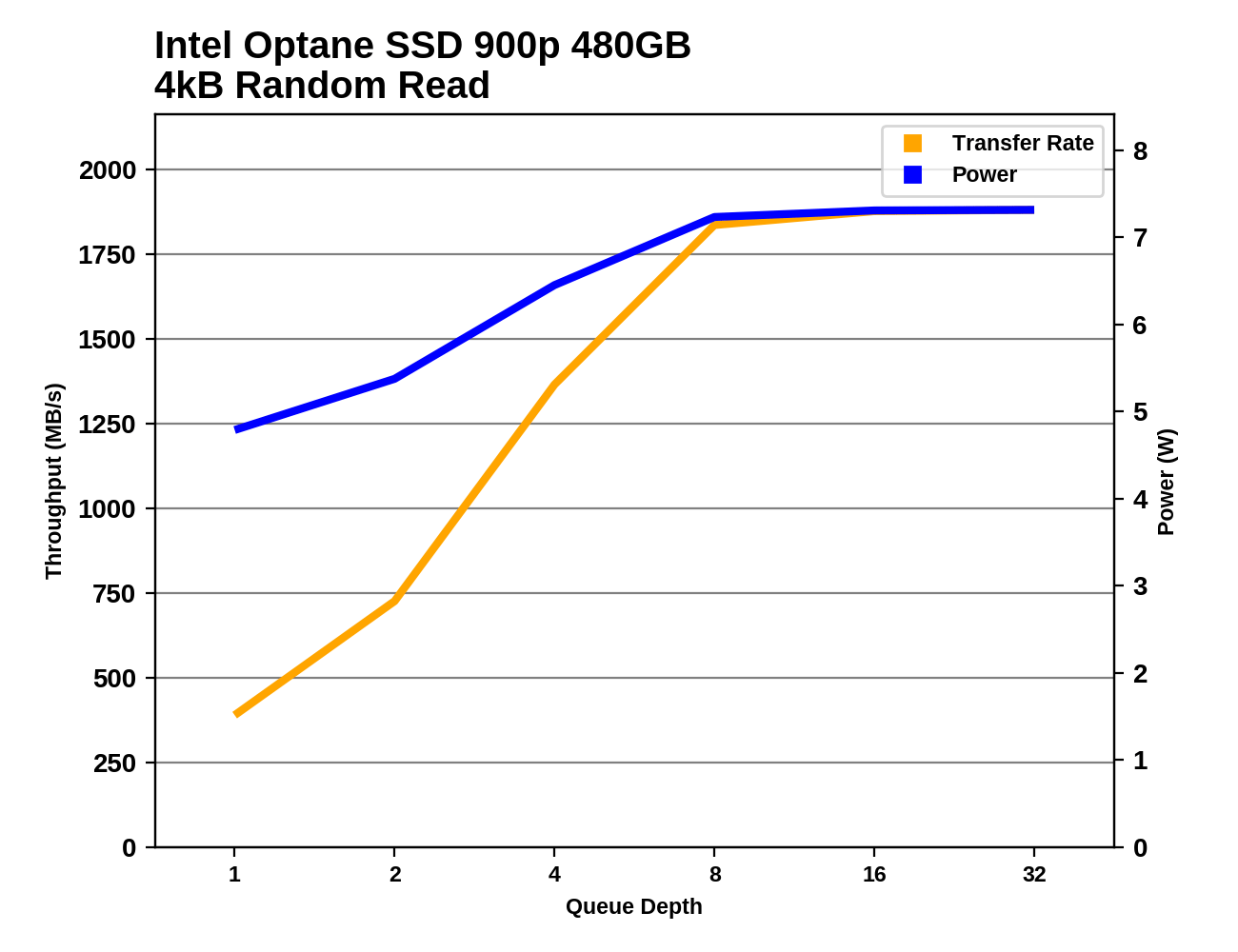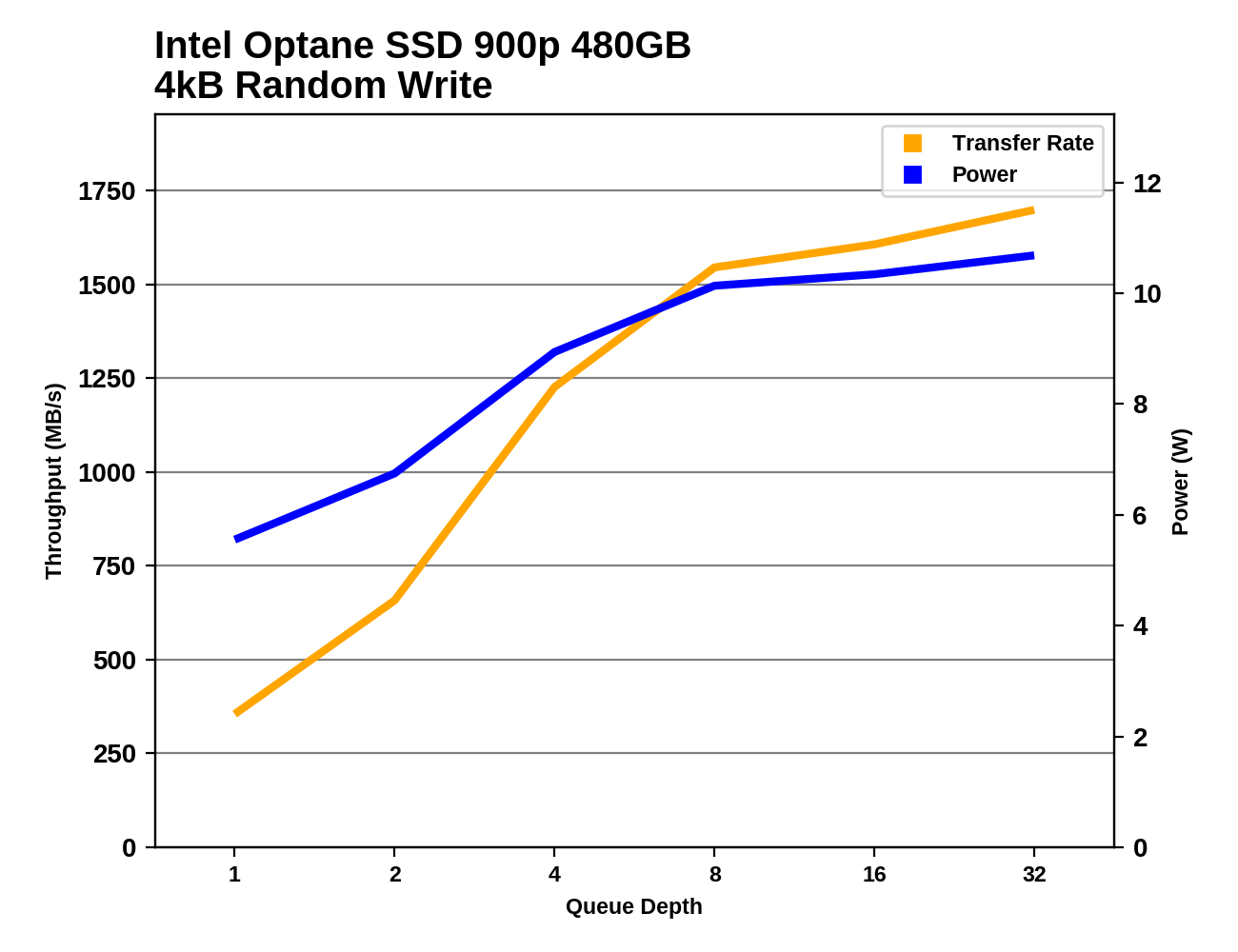The Intel Optane SSD 900p 480GB Review: Diving Deeper Into 3D XPoint
by Billy Tallis on December 15, 2017 12:15 PM ESTRandom Read Performance
Our first test of random read performance uses very short bursts of operations issued one at a time with no queuing. The drives are given enough idle time between bursts to yield an overall duty cycle of 20%, so thermal throttling is impossible. Each burst consists of a total of 32MB of 4kB random reads, from a 16GB span of the disk. The total data read is 1GB.

Random reads at queue depth 1 are where Intel's Optane products shine. Compared to the fastest NVMe SSDs using MLC NAND flash, the Optane SSDs aren't quite an order of magnitude faster, but only because the latency of the NVMe protocol over PCIe becomes the bottleneck. Intel's tiny Optane Memory M.2 cache drive is slightly faster in this one benchmark, but the difference hardly matters.
Our sustained random read performance is similar to the random read test from our 2015 test suite: queue depths from 1 to 32 are tested, and the average performance and power efficiency across QD1, QD2 and QD4 are reported as the primary scores. Each queue depth is tested for one minute or 32GB of data transferred, whichever is shorter. After each queue depth is tested, the drive is given up to one minute to cool off so that the higher queue depths are unlikely to be affected by accumulated heat build-up. The individual read operations are again 4kB, and cover a 64GB span of the drive.

Adding some higher queue depths to the average shows a small speed advantage for the 480GB Optane SSD over the 280GB model, and the Optane Memory M.2 starting to fall behind the larger Optane SSDs. The NAND flash-based SSDs also pick up speed as queue depths grow, but they need to go far beyond QD4 to catch up.

Given how thoroughly the Optane SSDs have shattered the record for random read performance, it's not too surprising to see them at the top of the charts for power efficiency when performing random reads. The 480GB Optane SSD is a bit less efficient than the smaller model because it has to power significantly more 3D XPoint memory chips with only a small performance boost to show for it. Compared to the flash-based SSDs, the Optane SSDs are only about 2.5 times more efficient, despite being about 7 times faster. The performance doesn't come for free.
 |
|||||||||
At low queue depths the two Optane SSDs offer nearly the same random read performance. When they both reach saturation at QD8, the 480GB model has slightly higher performance, and is drawing about 0.85W more power—a 13% power increase for a 7% performance boost.
Random Write Performance
Our test of random write burst performance is structured similarly to the random read burst test, but each burst is only 4MB and the total test length is 128MB. The 4kB random write operations are distributed over a 16GB span of the drive, and the operations are issued one at a time with no queuing.

The random write performance at queue depth 1 of the Optane SSDs is great, but not record-setting. Flash-based SSDs can cache write operations in their DRAM and report the command as complete before the data has actually made it to the flash memory. This means that for most flash-based SSDs the burst random write speed is more of a controller benchmark than a test of the storage itself. The Optane SSDs don't have large DRAM caches on the drive and are actually writing to the 3D XPoint memory almost as quickly as the Intel SSD 750 can stash the writes in its DRAM.
As with the sustained random read test, our sustained 4kB random write test runs for up to one minute or 32GB per queue depth, covering a 64GB span of the drive and giving the drive up to 1 minute of idle time between queue depths to allow for write caches to be flushed and for the drive to cool down.

With larger queue depths and test durations long enough to defeat any DRAM-based write caching and many SLC write caches, the Optane SSDs rise to the top. With this second round of testing, the 280GB Optane SSD performed slightly worse than the first run, but it's still essentially tied with the fastest flash-based SSDs. The 480GB model is a tiny bit faster than even the previous record from the 280GB model, putting it about 8% faster than the Samsung 960 PRO.

Without a huge performance lead, the high power consumption of the Optane SSDs takes a toll on their efficiency scores for random writes. They are ahead of early NVMe SSDs and on par with the fastest SATA SSDs, but the best current flash-based NVMe SSDs are substantially more efficient. The Toshiba XG5 prioritized efficiency over peak performance and ends up offering more than twice the power efficiency of the Optane SSDs, while the Samsung 960 EVO has a mere 77% efficiency advantage at essentially the same level of performance.
 |
|||||||||
As with random reads, the performance and power consumption gap between the two Optane SSD 900p capacities widens at higher queue depths. With power consumption starting at 5W and climbing to over 10W for the larger model, the Optane SSDs are in a completely different league from M.2 NVMe SSDs, which mostly top out around 4.5W.










69 Comments
View All Comments
ddriver - Friday, December 15, 2017 - link
Which is MLC...Samsung realized nobody is catching up in the nand market and decided to push consumer, high end and mainstream enterprise a notch down to TLC.
So now that MLC is only a "high end enterprise" thing in their portfolio, they decided to pimp it up with a new moniker - z-nand. Alas, it is just good old MLC with a barely incremental controller. And claim that it has anything to do with SLC performance - which it does as much as an a race horse harness makes an old donkey faster.
They REALLY aren't trying.
mapesdhs - Monday, December 18, 2017 - link
Do you have a link to Intel's original PR articlea about this tech? Other people keep saying you're wrong, but if there is indeed a piece of Intel PR that at least implied an initial launch would provide the sort of speed gains you mention, then you absolutely have a point.jospoortvliet - Thursday, December 21, 2017 - link
I have no link, but as pointed out below, there is a fight with a strawman going on here. Intel certainly talked about 1000x improvement in latency of flash vs Optane - at that point they are talking about time it takes for a single flash cell vs an Optane cell. As Flash can only write to a block or more, it is far far slower, optane can address a single cell directly. And sure, that might very well be 1000x faster in theory - and even already in this very first Optane SSD.But, just like if you make one component (eg a piston) in a car engine 1000x faster the entire car won't drive 1000x faster - the other components also contribute to speed, as do external factors like, you know, wind, asphalt... So the car gets 10% faster as a whole. You see the same here: even if that one part is 1000x faster, flash controllers use a ram cache and splitting data over a dozen channels to overcome the inherent limitation of flash while the NVME protocol and PCIExpress puts limits at latency improvements, so the end result is that the Optane PCIE devices are occasionally >10x faster than SSD's but generally a factor 3-5.
Of course, if you put them in a DDR4 slot, they'll be unleashed a bit more and would beat a DDR4 SSD solution probably by a factor 30-50 in most cases with peaks of 100x. Still not 1000 and it'll never be...
So, in short, even if Intel is 100% correct and an individual cell responds 1000x faster, its response has to be mediated by the controller, go over a data bus etc etc. so you'll never measure it like that.
jospoortvliet - Thursday, December 21, 2017 - link
And of course Intel just screams '1000x faster response time' without very clearly identifying they're talking about a theoretical maximum. Well, it is marketing. You take the best looking numbers that are defensible and use them.eddman - Thursday, December 21, 2017 - link
No, intel claimed it for 3D xpoint, NOT optane. Xpoint is the name of the tech, optane is the storage devices based on the tech.Kidster3001 - Wednesday, January 3, 2018 - link
Intel never claimed Optane to be 1000x faster than anything. The 1000x faster was in reference to 3D-XPoint. XPoint = the memory cells; Optane = the SSD product line. Two completely different things.ddrіver - Saturday, December 16, 2017 - link
I'm not myself when I drink.farazgomot - Saturday, December 16, 2017 - link
I fully agree, why almost everybody is caustic to ddriver when he correctly is critic to only the marketing hype , not that the product is in any way bad ( except for the high price/ capacity)lmcd - Saturday, December 16, 2017 - link
He's arguing semantics when ridiculous performance claims are an industry norm. He's argued those semantics for 5 straight articles, and arguing with literally every comment he can find this very point. It's in the ballpark of 100 belligerent comments on 5 articles, which frankly is far closer to "caustic" than our collective treatment. It's fine if he states his opinion, but we're tired of being screamed at.Reflex - Saturday, December 16, 2017 - link
The problem with ddriver is that he is arguing against a strawman that was built up in his own mind. Optane was never promised to produce products that could deliver 1000x performance boosts in the first generation. PCM is itself as much as 1000x faster than traditional NAND for many operations while being orders of magnitude more durable.However the fact that you are using Optane/PCM does not in some way fix the fact that controllers aren't capable of that kind of performance yet, that PCIe bandwidth is way behind that level, that system memory, chipsets and CPU's couldn't keep up with that, that the software stack is not optimized for that, etc etc.
Intel delivered, mostly on time and for a cheaper price than is typical for a first gen of a new technology. Since they have previously stated what the performance capabilities of Optane/PCM are, the focus now will be on other aspects of the platform in order to enable that capability. This removes a major performance roadblock as they move towards an optical bus and optical chips, and ensures that system storage is not the long pole.
I'm fairly excited, its been ten years since any major change in storage has occurred and now it is finally here. And its reasonably priced for what it delivers from the get go.